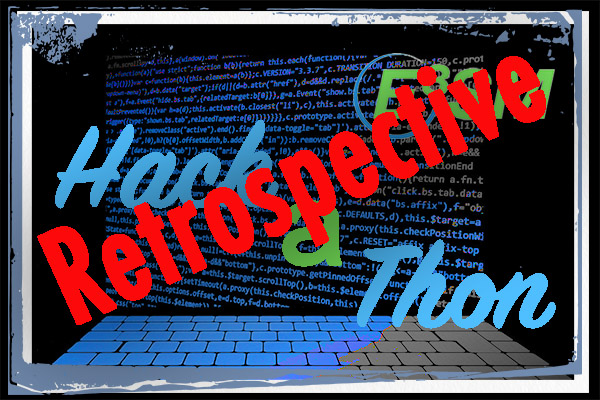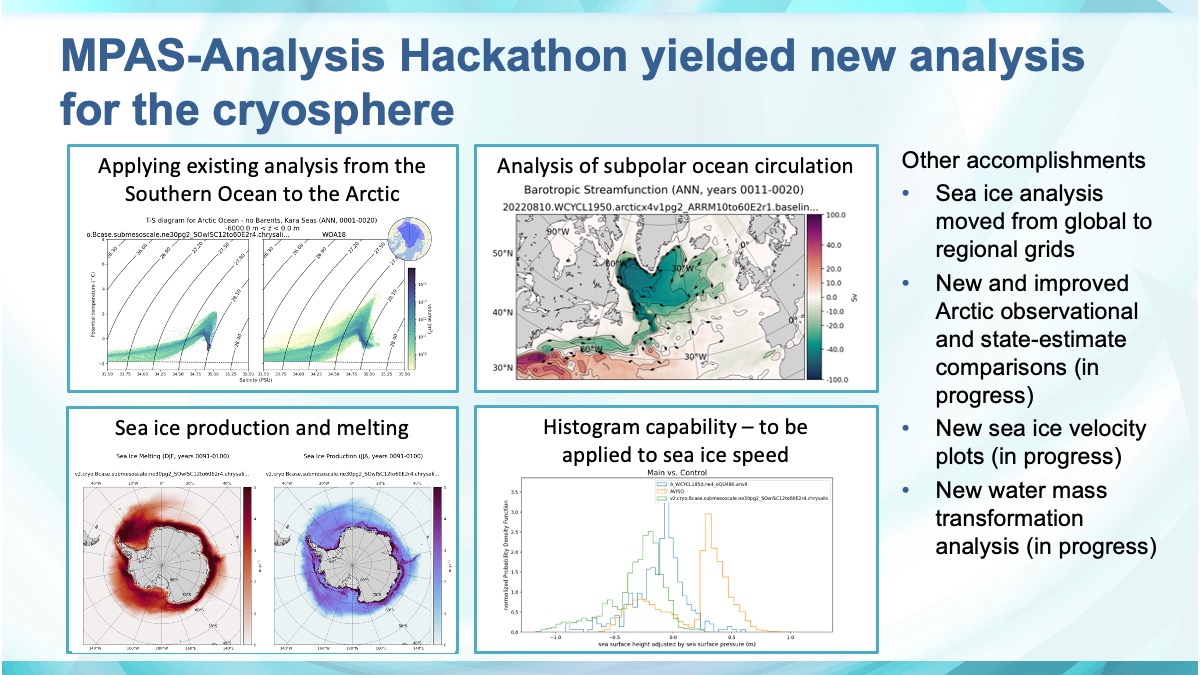Hackathon #2 Retrospective
 In September, Los Alamos National Laboratory hosted a hackathon on MPAS-Analysis, the software used to analyze E3SM output from ocean and sea ice components. The hackathon was a follow-on to the first E3SM hackathon held this May focusing on the MPAS Framework. There were nine participants, including staff scientists and postdocs, who tackled development tasks related to Arctic Ocean analysis, sea ice analysis, and the Atlantic Meridional Overturning Circulation (AMOC). The participants set these priorities at a pre-hackathon planning meeting based on project needs. The focus on the AMOC has been a high priority for the E3SM project more broadly, so it was deemed a priority to standardize some of the analysis developed by the AMOC Working Group. MPAS-Analysis has been missing some high-priority sea-ice analysis for many years, hence this was another focus of this hackathon. Finally, since several types of analysis for the Antarctic were developed as part of the Cryosphere Campaign, adapting these analyses to the Arctic was believed to be a good way of introducing new developers to MPAS-Analysis. Over the two-week hackathon duration, the hackathon participants made major progress on 9 different analysis projects and have made 17 pull requests (code change requests to the code base) with bug fixes and new analysis across all three of these areas, see Fig. 1 for examples of new analysis plots added to MPAS-Analysis.
In September, Los Alamos National Laboratory hosted a hackathon on MPAS-Analysis, the software used to analyze E3SM output from ocean and sea ice components. The hackathon was a follow-on to the first E3SM hackathon held this May focusing on the MPAS Framework. There were nine participants, including staff scientists and postdocs, who tackled development tasks related to Arctic Ocean analysis, sea ice analysis, and the Atlantic Meridional Overturning Circulation (AMOC). The participants set these priorities at a pre-hackathon planning meeting based on project needs. The focus on the AMOC has been a high priority for the E3SM project more broadly, so it was deemed a priority to standardize some of the analysis developed by the AMOC Working Group. MPAS-Analysis has been missing some high-priority sea-ice analysis for many years, hence this was another focus of this hackathon. Finally, since several types of analysis for the Antarctic were developed as part of the Cryosphere Campaign, adapting these analyses to the Arctic was believed to be a good way of introducing new developers to MPAS-Analysis. Over the two-week hackathon duration, the hackathon participants made major progress on 9 different analysis projects and have made 17 pull requests (code change requests to the code base) with bug fixes and new analysis across all three of these areas, see Fig. 1 for examples of new analysis plots added to MPAS-Analysis.
The organizers conducted a group reflection at the end of the first hackathon and adopted lessons learned to improve this hackathon. As a result, the group sessions each day were extended from 2 hours to 4 hours to allow for collaborative, dedicated coding time. Xylar Asay-Davis, one of the organizers, also developed hands-on tutorials that introduced everyone to the development approach and the code structure of an analysis task, giving the new developers the foundation they needed to make progress. The following resulting tutorials have been added to the MPAS-Analysis documentation for any new developers to use:
- Developer: Getting Started – MPAS-Analysis stable documentation
- Developers: Understanding an analysis task – MPAS-Analysis stable documentation
- Developers: Adding a new analysis task – MPAS-Analysis stable documentation
While the hackathon was successful in making progress on development tasks, a major motivation for the exercise was to build development capacity among the participants. The participants found the hackathon to be an important team-building experience, as they had the previous one held in May. Most participants expressed a preference for in-person time, though a hybrid in-person/remote format was again used to allow maximum participation. Those who had participated in the first hackathon found 4 hours per day (including social time in the form of coffee and lunch breaks) to be a major improvement over the 2-hour-per-day format of the first hackathon. Naturally, there were also a few lessons learned that could help future hackathons. One was that a “session zero” could be helpful, in which participants would learn the basics of setting up a development environment and running the code. If such a session for non-experts could happen in advance of the hackathon, participants could start the hackathon on a more even playing field. Another suggestion was to increase the number of participants to allow for better teaming up within the group while still retaining the close-knit feel. Feedback from participants was overwhelmingly positive and indicates that hackathons can be a productive, meaningful mode of collaboration for the E3SM team.
Hackathon organizers: Carolyn Begeman and Xylar Asay-Davis
Hackathon participants: Adrian Turner, Alice Barthel, Anirban Sinha, Carolyn Begeman, Darin Comeau, Jim Benedict, Kat Smith, Milena Veneziani, and Xylar Asay-Davis.
References
Contacts
- Xylar Asay-Davis, Los Alamos National Laboratory
- Carolyn Begeman, Los Alamos National Laboratory
This article is a part of the E3SM “Floating Points” Newsletter, to read the full Newsletter check:



